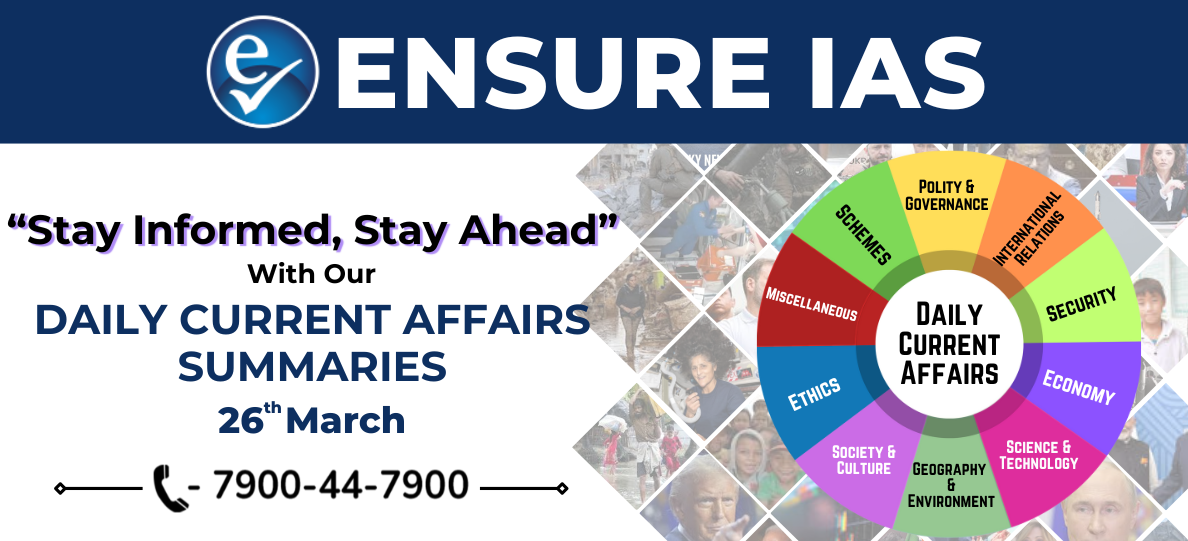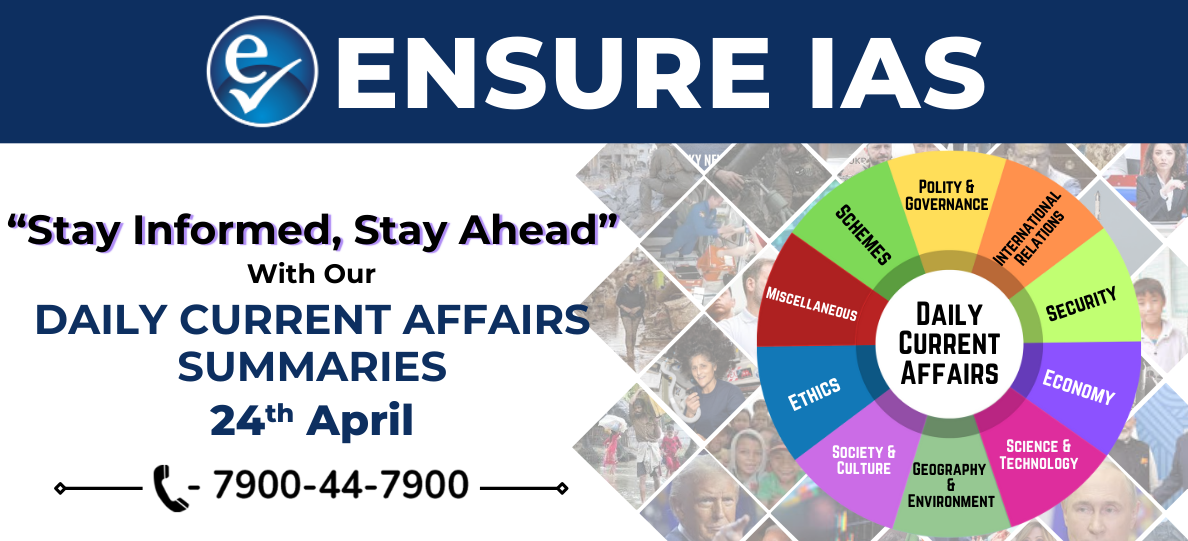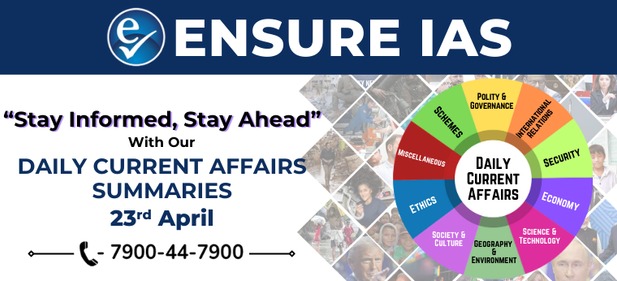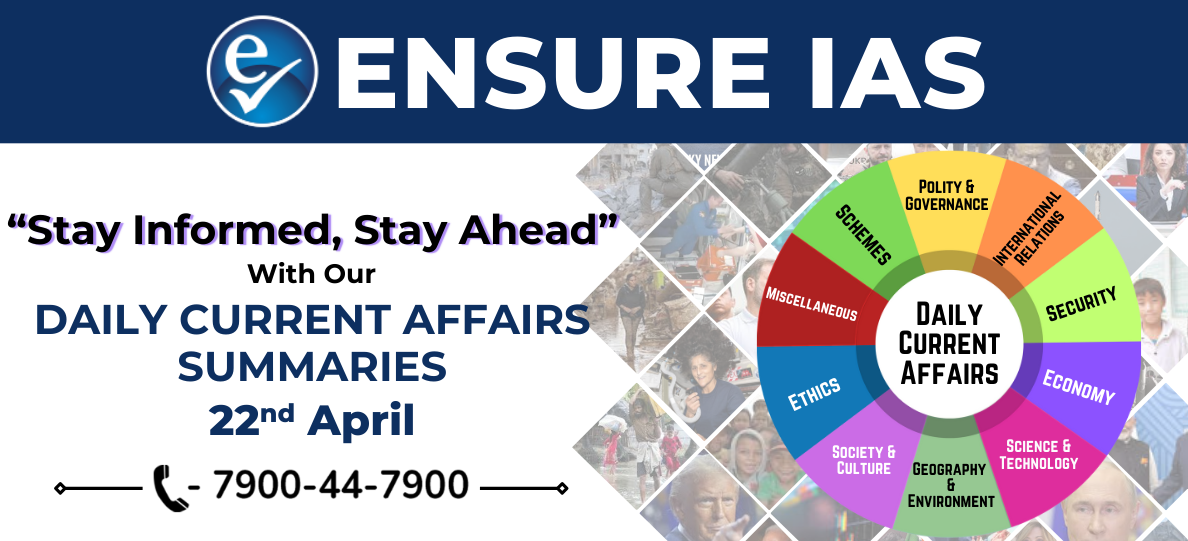- Courses
- GS Full Course 1 Year
- GS Full Course 2 Year
- GS Full Course 3 Year
- GS Full Course Till Selection
- CSAT
- 5 LAYERED ARJUNA Mentorship
- Public Administration Optional
- Online Program
- GS Recorded Course
- NCERT Batch
- Polity Module Course
- Geography Module Course
- Economy Module Course
- AMAC Module Course
- Modern India, Post Independence & World History Module Course
- Environment Module Course
- Governance Module Course
- Science & Tech. Module Course
- International Relations and Internal Security Module Course
- Disaster Management Module Course
- Ethics Module Course
- Essay Module Course
- Current Affairs Module Course
- ABOUT US
- OUR TOPPERS
- TEST SERIES
- FREE STUDY MATERIAL
- VIDEOS
- CONTACT US
Daily Current Affairs Summary - 26th March 2025
Daily Current Affairs Summary - 26th March 2025

Indian Navy's Initiatives: IOS Sagar and AIKEYME
The Indian Navy has launched two significant initiatives—Indian Ocean Ship (IOS) Sagar and Africa India Key Maritime Engagement (AIKEYME)—to strengthen its position as the ‘Preferred Security Partner’ and ‘First Responder’ in the Indian Ocean Region (IOR). These initiatives aim to enhance regional maritime security and foster cooperation among friendly nations.
Indian Ocean Ship (IOS) Sagar
- As part of this initiative, the Indian Navy’s INS Sunayna has been deployed to the Southwest Indian Ocean Region (IOR).
- The ship is manned by a combined crew comprising naval personnel from India and nine friendly countries:
- Comoros, Kenya, Madagascar, Maldives, Mauritius, Mozambique, Seychelles, Sri Lanka, and South Africa.
- This collaborative effort is designed to strengthen maritime ties and promote regional security through joint operations and exercises.
Africa India Key Maritime Engagement (AIKEYME)
- AIKEYME, derived from the Sanskrit word meaning "Unity," is a multilateral maritime exercise that focuses on improving interoperability between Indian and African naval forces.
- It is a joint initiative co-hosted by India and Tanzania, with participation from Comoros, Djibouti, Eritrea, Kenya, Madagascar, Mauritius, Mozambique, Seychelles, and South Africa.
- The exercise aims to enhance coordination in maritime security, disaster response, and operational synergy, reinforcing the collective commitment to ensuring stability in the region.
Dalle Chilly from Sikkim Makes Its Way to the Solomon Islands
The Agricultural and Processed Food Products Export Development Authority (APEDA) has successfully exported the first consignment of GI-tagged Dalle Chilly from Sikkim to the Solomon Islands.
What is Dalle Chilly?
- Also known as Fire Ball Chilly or Dalle Khursani, this variety is famous for its intense spiciness, vibrant red color, and rich nutritional content.
- It is packed with essential vitamins such as A, C, and E, along with potassium, making it not only a fiery spice but also a healthy addition to diets.
- Its Scoville Heat Units (SHU) range between 100,000 to 350,000, placing it among the world’s hottest chillies.
Cryogenic Conservation Initiative
- The Padmaja Naidu Himalayan Zoological Park (PNHZP) in Darjeeling, West Bengal, has made history by becoming India’s first zoo to preserve DNA samples of wildlife species found in snowy regions.
- This pioneering effort is part of the Cryogenic Preservation Initiative, which aims to safeguard the genetic material of rare and endangered species.
About the Cryogenic Conservation Initiative
- The initiative was launched by PNHZP in collaboration with the Centre for Cellular and Molecular Biology (CCMB), Hyderabad.
- It focuses on storing DNA samples of Himalayan wildlife through cryogenic methods, ensuring that their genetic material remains intact for future use.
- The primary goal is to support conservation research and provide a genetic backup in case certain species face the threat of extinction.
About Padmaja Naidu Himalayan Zoological Park (PNHZP)
- Located in Darjeeling, PNHZP is India’s highest-altitude zoological park.
- It is renowned for its conservation programs, particularly for the Snow Leopard and Red Panda, both of which are endangered species.
National Organ & Tissue Transplant Organization (NOTTO) and the Need for Better Data Sharing
The Union Government has raised serious concerns regarding hospitals failing to share data on organ transplantation activities with the National Organ & Tissue Transplant Organization (NOTTO). This lack of compliance affects transparency and efficiency in India's organ transplant system.
What is NOTTO?
The National Organ & Tissue Transplant Organization (NOTTO) serves as the apex body for implementing the National Organ Transplant Program (NOTP). It functions under the Directorate General of Health Services (DGHS), Ministry of Health and Family Welfare, and operates in accordance with the Transplantation of Human Organs and Tissues Act (THOTA), 1994.
Key Roles and Functions of NOTTO:
- Establishes a systematic and transparent process for organ procurement and distribution across India.
- Maintains a national registry of donors and recipients for organs and tissues.
- Ensures ethical and regulated transplantation practices across hospitals.
Divisions of NOTTO:
- National Human Organ and Tissue Removal and Storage Network – Manages the nationwide framework for retrieval, storage, and distribution of organs.
- National Biomaterial Centre (National Tissue Bank) – Responsible for collecting, storing, and supplying tissues for transplantation and medical research.
IEA’s Global Energy Review 2025
The International Energy Agency (IEA) has released its Global Energy Review 2025, providing an in-depth analysis of energy trends and developments worldwide. The report highlights significant shifts in energy consumption, the growing role of renewables, and the impact of clean technologies on carbon emissions.
Key Highlights of the Report
- Global Energy Demand:
- In 2024, global energy demand increased by 2.2%, with Emerging and Developing Economies contributing over 80% of this growth.
- This surge was primarily driven by industrial expansion, urbanization, and rising energy consumption in fast-growing economies.
- Rise of Renewable and Nuclear Energy:
- Renewable energy sources and nuclear power together accounted for 80% of the global increase in electricity generation in 2024.
- For the first time, these two sources contributed 40% of the total electricity generation worldwide.
- Impact of Clean Technologies on Carbon Emissions:
- The large-scale deployment of solar PV, wind energy, nuclear power, electric vehicles, and heat pumps since 2019 has led to a significant reduction in carbon emissions.
- These technologies now prevent 2.6 billion tonnes of CO₂ emissions annually, which is equivalent to 7% of total global emissions
Rushikonda Beach Regains Prestigious Blue Flag Certification
- Rushikonda Beach in Visakhapatnam, Andhra Pradesh, has successfully regained its Blue Flag certification, which was previously withdrawn due to inadequate maintenance.
- This recognition reaffirms the beach’s commitment to environmental sustainability and cleanliness.
Significance of Rushikonda Beach's Achievement
- Rushikonda Beach is the only Blue Flag-certified beach in Andhra Pradesh.
- It is among the 13 Blue Flag beaches in India, highlighting its adherence to international standards of cleanliness, safety, and eco-friendliness.
About the Blue Flag Certification
- What it Recognizes:
- Awarded to beaches, marinas, and sustainable tourism boats that meet high environmental and safety standards.
- Who Confers It:
- Granted by the Denmark-based Foundation for Environmental Education (FEE).
- Eligibility Criteria:
- Applicants must comply with strict environmental, educational, safety, and accessibility benchmarks to receive and retain the certification.
Varuna Exercise 2025: India-France Naval Cooperation
The Varuna Exercise 2025, a key bilateral naval drill between India and France, recently concluded, reinforcing strategic ties and maritime collaboration between the two nations.
Key Highlights of Varuna 2025
- Participating Nations: India and France
- Location: Arabian Sea
- Objective:
- Strengthening joint operational capabilities between the two navies.
- Upholding a rules-based maritime order.
- Enhancing stability in the Indo-Pacific region.
Major Drills and Operations
The exercise featured mock air-to-air combat, where France’s Rafale-M fighters engaged in simulated dogfights with India’s MiG-29K aircraft, showcasing advanced aerial combat techniques and interoperability.
DNA Polymorphism and Its Modern Applications
DNA polymorphism plays a crucial role in forensics and medicine, offering valuable insights into genetic variation and individual identification.
What is DNA Polymorphism?
- It refers to genetic variations in specific DNA segments or genes among individuals.
- These variations help in differentiating individuals at a molecular level.
Techniques Used to Detect DNA Polymorphism
- Restriction Fragment Length Polymorphism (RFLP) – Analyzes differences in DNA fragment patterns after enzyme digestion.
- Variable Number of Tandem Repeats (VNTR) Polymorphism – Identifies genetic variations based on repeating sequences of DNA.
Short Tandem Repeats (STRs) and DNA Profiling
- DNA profiling relies on polymorphic regions known as Short Tandem Repeats (STRs).
- STRs consist of short, repeated sequences of base pairs in DNA, which vary in number from person to person, making them ideal for identification purposes.
Applications of DNA Polymorphism
- Molecular and Personalized Medicine – Helps in genetic disease identification and targeted therapies.
- Forensic DNA Analysis – Used in crime investigations for suspect identification.
- DNA Linkage Analysis – Assists in tracing hereditary diseases and ancestry studies.
- Human Identification – Differentiates individuals based on genetic markers.
Revised MSME Classification Criteria Notified
- The Union Government has officially notified the revised investment and turnover criteria for classifying Micro, Small, and Medium Enterprises (MSMEs).
- Announced earlier in the Union Budget 2025-26, these new criteria will come into effect from April 1, 2025.
Updated MSME Classification Criteria
|
Category |
Investment Limit |
Annual Turnover Limit |
|
Micro Enterprises |
Up to ₹22.5 crore (Earlier ₹21 crore) |
Up to ₹210 crore (Earlier ₹25 crore) |
|
Small Enterprises |
Up to ₹25 crore (Earlier ₹10 crore) |
Up to ₹100 crore (Earlier ₹50 crore) |
|
Medium Enterprises |
Up to ₹125 crore (Earlier ₹50 crore) |
Up to ₹500 crore (Earlier ₹250 crore) |
Significance of MSMEs in India
- Employment Generation: The sector comprises 5.93 crore registered MSMEs, providing jobs to over 25 crore people.
- Economic Contribution: MSME-driven industries accounted for 45.73% of India’s total exports in 2023-24.
- GDP Share: The Gross Value Added (GVA) by MSMEs rose from 27.3% in 2020-21 to 30.1% in 2022-23.
- Rural Industrialization: MSMEs play a key role in developing rural and backward areas, reducing regional disparities and ensuring equitable wealth distribution.
Challenges Faced by MSMEs
Despite their significance, MSMEs encounter several hurdles, including:
- Infrastructure bottlenecks and lack of essential facilities.
- Slow formalization of businesses and regulatory challenges.
- Hesitation in adopting new technologies due to costs and training gaps.
- Weak supply chain integration affecting competitiveness.
- Limited access to credit and risk capital, hampering expansion.
- Delayed payments from buyers, affecting cash flow and operations.
Government Initiatives to Support MSMEs
To enhance the growth and sustainability of MSMEs, the government has launched several initiatives:
- Udyam Registration Portal – A digital platform simplifying MSME registration and access to benefits.
- PM Vishwakarma – A scheme providing financial and social support to artisans and craftspeople to improve their livelihood.
- Prime Minister’s Employment Generation Programme (PMEGP) – A credit-linked subsidy initiative for setting up micro-enterprises in the non-farm sector.
- SFURTI (Scheme of Fund for Regeneration of Traditional Industries) – Organizes traditional artisans into clusters to improve productivity and market access.
Enhancing CSR, IBC, and ESG Regulations
The 10th report on ‘Demands for Grants (2025-26)’ by the Ministry of Corporate Affairs (MCA) highlights key challenges in Corporate Social Responsibility (CSR), the Insolvency and Bankruptcy Code (IBC), and Environmental, Social, and Governance (ESG) regulations.
The report provides crucial recommendations to improve the effectiveness of these frameworks.
Key Areas, Challenges, and Recommendations
1. Corporate Social Responsibility (CSR)
Issues:
- Gaps in enforcement and monitoring of CSR compliance.
- Lack of detailed evaluation of the effectiveness and impact of CSR spending.
- Unspent CSR Account Mechanism lacks transparency, leading to inefficiencies in fund utilization.
Recommendations:
- Develop a more structured reporting and monitoring system to ensure CSR activities generate measurable impact.
- Introduce regular publication of reports assessing the effectiveness and social outcomes of CSR projects.
- Enforce penalties in a timely manner for non-compliance to strengthen accountability.
2. Insolvency and Bankruptcy Code (IBC)
Issues:
- Delays in resolution processes due to conflicts of interest and inconsistent interpretations of IBC provisions.
- Absence of a strong framework for handling complaints against Resolution Professionals (RPs).
Recommendations:
- Implement a centralized online portal for the direct submission of resolution plans, reducing bureaucratic delays.
- Strengthen certification requirements for RPs and conduct independent performance reviews to improve efficiency.
- Revamp the structure of the Committee of Creditors (CoC) to ensure better representation of operational creditors in decision-making.
3. Environmental, Social, and Governance (ESG) Regulations
Issues:
- Growing concerns over greenwashing, where companies misrepresent their sustainability efforts.
- Small businesses struggle to integrate ESG practices due to financial and technical constraints.
Recommendations:
- Set up a dedicated ESG oversight body within the ministry to monitor compliance and introduce penalties for greenwashing.
- Amend the Companies Act, 2013, to make ESG objectives part of the fiduciary duties of company directors.
- Create independent ESG committees similar to audit committees, ensuring corporate accountability and transparency.
Tackling Black Carbon: How to Unlock Fast Climate and Clean Air Benefits
- The Clean Air Fund recently released a report titled “Tackling Black Carbon: How to Unlock Fast Climate and Clean Air Benefits”, emphasizing the urgent need to curb black carbon emissions.
- The report underscores that reducing black carbon and other super pollutants is the fastest way to achieve immediate climate benefits, enhance air quality, safeguard public health, and strengthen economic resilience.
Understanding Black Carbon
- Black carbon, commonly referred to as soot, is a major component of PM2.5 (fine particulate air pollution).
- It is classified as a Short-Lived Climate Pollutant (SLCP), meaning it remains in the atmosphere only for days to weeks but has a high warming potential.
- India ranks as the world’s second-largest emitter of black carbon, following China.
Impacts of Black Carbon
1. Contribution to Global Warming: Black carbon is a potent climate forcer, along with methane, and is responsible for nearly half of global warming.
2. Acceleration of Ice and Glacier Melting
- Black carbon settles on snow and ice, darkening surfaces and reducing their ability to reflect sunlight (albedo effect).
- This accelerates glacial melting, particularly in the Arctic and Himalayas.
- Notably, black carbon is responsible for 39% of the mass loss of Yala Glacier on the Tibetan Plateau.
3. Disruption of Monsoon and Hydrological Cycles
- Black carbon emissions alter rainfall patterns, intensifying flood risks in some areas while exacerbating droughts in others.
- It significantly impacts the Asian and West African monsoon systems, leading to unpredictable weather patterns.
Key Recommendations
1. Targeting Black Carbon Emissions in High-Impact Sectors
- Focus on reducing emissions from gas flaring, shipping, and residential heating, particularly in and around the Arctic.
2. Integrating Black Carbon Reduction into National Policies
- Countries should include black carbon reduction targets in their clean air and energy policies.
- Incorporating these targets into Nationally Determined Contributions (NDCs) under the Paris Agreement will enhance climate commitments.
3. Implementing Coordinated Super-Pollutant Mitigation Strategies
- Develop comprehensive waste management systems to tackle emissions from agricultural waste burning, landfill fires, and inefficient biomass combustion.
RBI Revises Priority Sector Lending Guidelines – Effective from April 1, 2025
- The Reserve Bank of India (RBI) has issued revised Priority Sector Lending (PSL) guidelines, set to take effect from April 1, 2025.
- These guidelines have been introduced under the authority granted by Sections 21 and 35A, read with Section 56 of the Banking Regulation Act, 1949.
- The revisions focus on enhancing credit accessibility, increasing loan limits, and expanding the scope of PSL categories.
Key Changes in Priority Sector Lending (PSL) Guidelines
1. Enhancement of Loan Limits
RBI has increased the maximum loan limits across multiple priority sectors:
- Education Loans: Up to ₹25 lakh per individual, covering vocational courses as well.
- Social Infrastructure Loans: Up to ₹8 crore per borrower for projects like school construction, drinking water facilities, and sanitation infrastructure.
- Other Sectors: Increased loan limits for housing and agriculture loans to improve financial accessibility in these sectors.
2. Greater Focus on Renewable Energy
To promote sustainability, PSL guidelines now prioritize renewable energy projects:
- Funding for Renewable Energy-Based Power Generators & Public Utilities:
- Loans up to ₹35 crore for renewable energy-based power plants, street lighting systems, and village electrification projects.
- Support for Individual Households:
- Loan limit of ₹10 lakh per household for renewable energy installations.
3. Revised PSL Targets for Urban Co-operative Banks (UCBs)
Urban Co-operative Banks (UCBs) now have higher PSL targets, ensuring more credit flow into priority sectors:
- Total Priority Sector Lending: 60%
- Micro Enterprises: 7.5%
- Advances to Weaker Sections: 12%
4. Expansion of the ‘Weaker Sections’ Category
The definition of Weaker Sections has been broadened to include transgender individuals, alongside the existing categories:
- Small & Marginal Farmers
- Distressed Farmers (indebted to non-institutional lenders)
- Artisans
- Members of Self-Help Groups (SHGs) and Joint Liability Groups (JLGs)
- Scheduled Castes (SCs) & Scheduled Tribes (STs)
- Persons with Disabilities
- Minority Communities (as per Government of India notifications)
- Individual Women Beneficiaries (up to ₹2 lakh) – Not applicable to UCBs
Priority Sector Lending Targets & Sub-Targets
|
Categories |
Domestic Commercial Banks & Foreign Banks (≥20 branches) |
Foreign Banks (<20 branches) |
Regional Rural Banks (RRBs) |
Small Finance Banks (SFBs) |
|
Total PSL |
40% |
40% (Up to 32% in Export Credit) |
75% |
75% |
|
Agriculture |
18% |
Not Applicable |
18% |
18% |
|
Micro Enterprises |
7.5% |
Not Applicable |
7.5% |
7.5% |
|
Weaker Sections |
12% |
Not Applicable |
15% |
12% |
Note: The percentages mentioned above are calculated based on Adjusted Net Bank Credit (ANBC) or Credit Equivalent of Off-Balance Sheet Exposures (CEOBSE), whichever is higher.
|
Also Read |
|
| NCERT Books For UPSC | |
| UPSC Monthly Magazine | Best IAS Coaching in Delhi |




